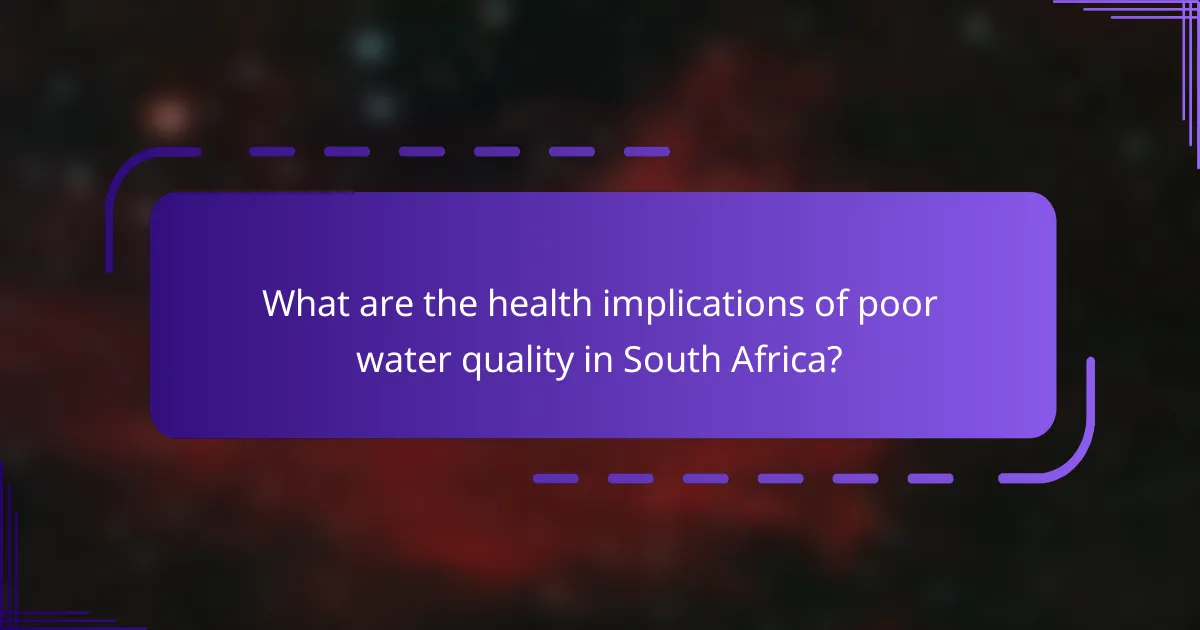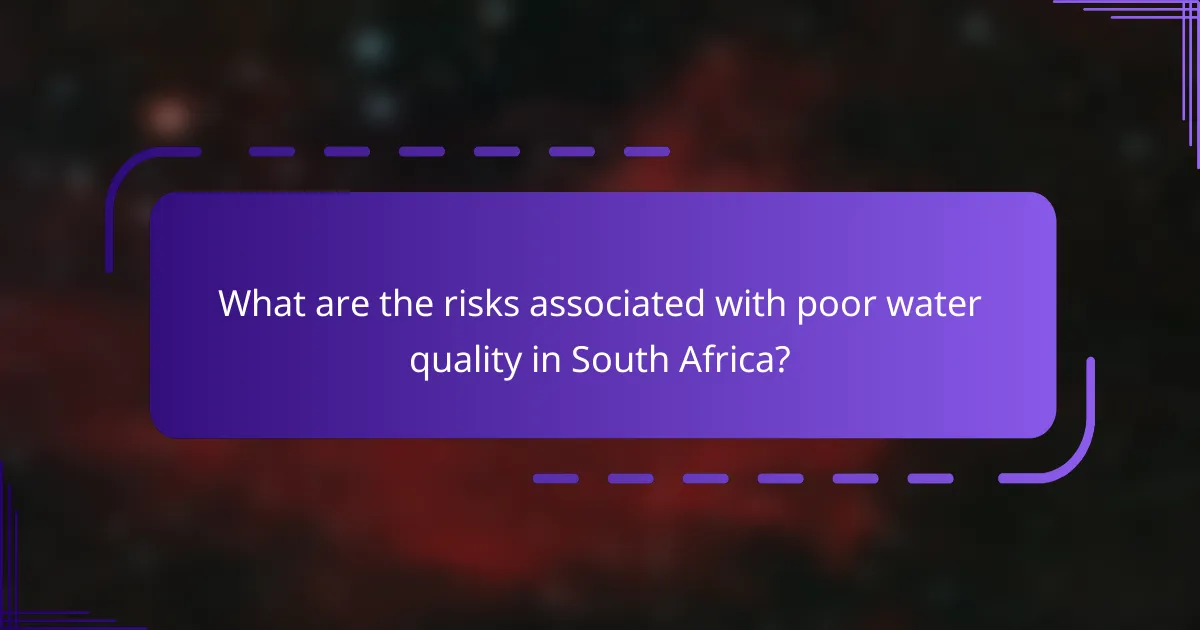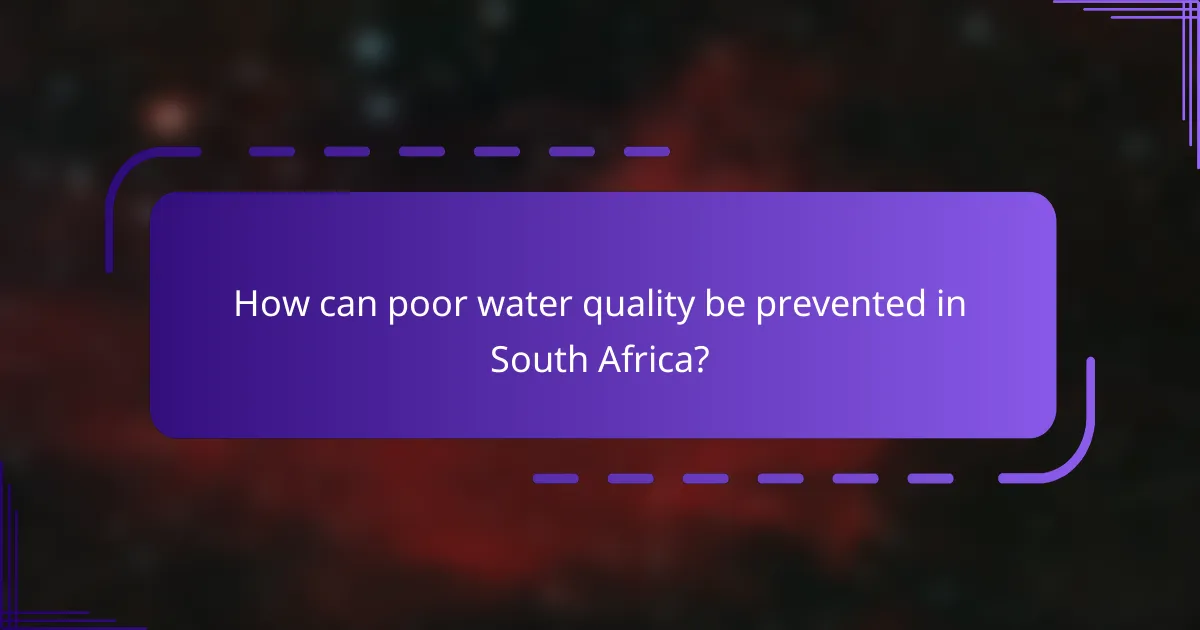Poor water quality in South Africa is a critical public health issue that contributes to significant health risks, including waterborne diseases such as cholera and dysentery. Contaminated water sources, often laden with pathogens and heavy metals, lead to both immediate health threats and long-term complications, particularly for vulnerable groups like children and the elderly. The World Health Organization has highlighted the severe impact of unsafe drinking water, which is linked to over 500,000 annual deaths from diarrheal diseases. Additionally, the presence of toxins in irrigation water raises food safety concerns, further exacerbating health disparities. Effective strategies for improving water quality include enhancing treatment facilities, enforcing regulations on waste disposal, raising community awareness, adopting sustainable agricultural practices, and increasing funding for research.

What are the health implications of poor water quality in South Africa?
Poor water quality in South Africa has significant health implications. Contaminated water sources can lead to waterborne diseases such as cholera and dysentery. These diseases are particularly dangerous for vulnerable populations, including children and the elderly. A 2018 report by the World Health Organization indicated that South Africa has experienced multiple cholera outbreaks linked to poor water quality. Additionally, heavy metals in water can cause long-term health issues, including kidney damage and developmental problems in children. The lack of access to clean water exacerbates existing health disparities in the country. Overall, poor water quality poses severe risks to public health in South Africa.
How does poor water quality affect public health?
Poor water quality significantly impacts public health. Contaminated water can lead to waterborne diseases such as cholera, dysentery, and typhoid. These diseases cause severe gastrointestinal issues and can be fatal, particularly in vulnerable populations. According to the World Health Organization, approximately 2 billion people globally lack access to safe drinking water, increasing the risk of disease. In South Africa, poor water quality has been linked to outbreaks of diseases, highlighting the urgent need for clean water access. Additionally, long-term exposure to contaminated water can result in chronic health issues, including kidney damage and developmental problems in children. Access to safe water is essential for preventing these health risks.
What specific diseases are linked to contaminated water?
Contaminated water is linked to several specific diseases. Common diseases include cholera, which is caused by Vibrio cholerae bacteria. Typhoid fever results from Salmonella typhi and is another serious illness linked to unsafe water. Dysentery, caused by Shigella bacteria or amoebas, can also occur due to contaminated water sources. Hepatitis A is a viral infection that can spread through polluted water. Additionally, gastroenteritis is often associated with waterborne pathogens. According to the World Health Organization, these diseases pose significant health risks, particularly in areas with inadequate sanitation and water treatment.
How does the quality of drinking water impact vulnerable populations?
The quality of drinking water significantly impacts vulnerable populations by increasing their risk of waterborne diseases. Poor water quality can lead to illnesses such as cholera, dysentery, and typhoid fever. These diseases disproportionately affect children, the elderly, and those with weakened immune systems. According to the World Health Organization, contaminated water causes over 500,000 deaths annually from diarrheal diseases. Vulnerable populations often lack access to safe drinking water, exacerbating health disparities. In South Africa, areas with inadequate water infrastructure see higher rates of illness among low-income communities. Access to clean water is essential for maintaining public health and preventing outbreaks.
What are the symptoms of health issues caused by poor water quality?
Symptoms of health issues caused by poor water quality include gastrointestinal illnesses, skin rashes, and respiratory problems. Gastrointestinal issues often manifest as diarrhea, nausea, and vomiting. Skin rashes can occur due to exposure to contaminated water. Respiratory problems may arise from inhaling waterborne pathogens. Fever and headaches are also common symptoms. In severe cases, long-term exposure can lead to chronic health conditions. Studies indicate that poor water quality significantly increases the risk of these health issues. For instance, the World Health Organization reports that unsafe drinking water is linked to over 500,000 deaths annually from diarrhea alone.
What common symptoms arise from waterborne illnesses?
Common symptoms of waterborne illnesses include diarrhea, nausea, vomiting, and abdominal pain. These symptoms often arise due to the ingestion of contaminated water. Diarrhea can lead to dehydration, which is particularly dangerous for vulnerable populations. Nausea and vomiting are also frequent reactions as the body attempts to expel harmful pathogens. Abdominal pain may accompany these gastrointestinal symptoms. In some cases, individuals may experience fever and fatigue as the body fights off infections. According to the World Health Organization, contaminated water can transmit diseases like cholera and dysentery, which are characterized by these symptoms.
How can individuals recognize signs of water-related health problems?
Individuals can recognize signs of water-related health problems by monitoring specific symptoms. Common indicators include gastrointestinal issues such as diarrhea and vomiting. Skin rashes and irritations can also signal contamination. Fever and chills may accompany waterborne infections. Unexplained fatigue and weakness are additional warning signs. Individuals should pay attention to unusual odors or discoloration in water. Noticing an increase in illness among community members can indicate broader issues. Prompt medical consultation is essential for persistent symptoms.

What are the risks associated with poor water quality in South Africa?
Poor water quality in South Africa poses significant health risks. Contaminated water can lead to waterborne diseases such as cholera and dysentery. These diseases are caused by pathogens found in unsafe drinking water. According to the World Health Organization, unsafe water contributes to over 500,000 deaths annually from diarrheal diseases.
Additionally, poor water quality can result in long-term health issues. Heavy metals like lead and mercury can accumulate in the body, causing neurological and developmental problems. The South African Department of Water and Sanitation has reported that many communities lack access to safe drinking water, increasing these health risks.
Furthermore, poor water quality affects food safety. Irrigation with contaminated water can lead to toxic substances entering the food chain. This can result in foodborne illnesses and further health complications for consumers.
In summary, the risks associated with poor water quality in South Africa include waterborne diseases, long-term health issues from contaminants, and food safety concerns.
What factors contribute to poor water quality in South Africa?
Poor water quality in South Africa is influenced by several key factors. Pollution from industrial discharges contaminates water sources. Agricultural runoff introduces harmful pesticides and fertilizers into rivers and lakes. Inadequate sanitation facilities lead to fecal contamination of water supplies. Aging infrastructure causes leaks and breaks, allowing pollutants to enter the system. Climate change exacerbates water scarcity and affects water quality. Deforestation and land degradation increase sedimentation in water bodies. Lastly, inadequate regulatory enforcement allows continued violations of water quality standards. These factors collectively contribute to the ongoing challenges of maintaining safe water in South Africa.
How do industrial activities affect water sources?
Industrial activities contaminate water sources through the discharge of pollutants. Factories often release chemicals, heavy metals, and waste into nearby rivers and lakes. This contamination can lead to severe ecological damage. For example, the mining industry frequently introduces toxic substances like arsenic and lead into water bodies. Agricultural runoff from industrial farming also contributes pesticides and fertilizers, causing eutrophication. According to the World Health Organization, polluted water can lead to health issues such as cholera and dysentery. In South Africa, the Department of Water and Sanitation reported that industrial pollution significantly affects the quality of water in many regions.
What role does climate change play in water quality deterioration?
Climate change significantly contributes to water quality deterioration. Rising temperatures can increase the frequency of harmful algal blooms. These blooms produce toxins that contaminate drinking water sources. Additionally, climate change leads to altered precipitation patterns. Increased rainfall can cause runoff, carrying pollutants into water bodies. Droughts, on the other hand, concentrate contaminants in limited water supplies. Changes in temperature and precipitation also affect the natural filtration processes in ecosystems. Research indicates that these changes can exacerbate existing water quality issues. For example, a study by the World Health Organization highlights the link between climate change and increased waterborne diseases.
What are the long-term health risks of consuming contaminated water?
Consuming contaminated water poses significant long-term health risks. Chronic exposure can lead to gastrointestinal diseases, including dysentery and cholera. Contaminated water may also contain heavy metals, leading to kidney damage and neurological disorders. Long-term consumption can result in developmental issues in children due to exposure to toxins. Additionally, it can increase the risk of cancer from carcinogenic substances present in polluted water. According to the World Health Organization, around 2 billion people globally use drinking water contaminated with feces, leading to severe health outcomes. In South Africa, poor water quality has been linked to numerous health crises, emphasizing the urgent need for improved water safety measures.
How does chronic exposure to poor water quality impact overall health?
Chronic exposure to poor water quality significantly impacts overall health. It can lead to various health issues, including gastrointestinal diseases, respiratory problems, and neurological disorders. Contaminated water often contains pathogens, heavy metals, and chemicals. These contaminants can cause infections and long-term health complications. For instance, the World Health Organization states that unsafe water can lead to diseases like cholera and dysentery. Additionally, heavy metals like lead and mercury can cause developmental issues in children. Studies show that regions with poor water quality experience higher rates of morbidity and mortality. Access to clean water is essential for maintaining public health and preventing these adverse effects.
What are the potential mental health effects linked to water quality issues?
Poor water quality can significantly impact mental health. Contaminated water sources can lead to increased anxiety and stress levels. Exposure to pollutants may contribute to cognitive decline and mood disorders. Research indicates a correlation between waterborne diseases and mental health issues. For instance, studies show that communities with poor water quality report higher instances of depression. The stress of dealing with health problems related to water can exacerbate existing mental health conditions. This link underscores the importance of clean water for overall well-being.

How can poor water quality be prevented in South Africa?
Improving water quality in South Africa can be achieved through several key strategies. First, enhancing water treatment facilities is essential. Upgrading existing infrastructure ensures cleaner water supply. Second, implementing strict regulations on industrial waste disposal protects water sources. Monitoring compliance helps prevent contamination. Third, promoting community awareness about water conservation practices is crucial. Educating citizens on pollution prevention can lead to better local water management. Fourth, investing in sustainable agricultural practices reduces runoff pollutants. Practices like crop rotation and organic farming can minimize chemical use. Finally, increasing funding for water quality research supports long-term solutions. Research informs policy and improves technology for water purification. These combined efforts can significantly mitigate poor water quality in South Africa.
What strategies are effective in improving water quality?
Effective strategies for improving water quality include implementing advanced filtration systems, promoting sustainable agricultural practices, and enhancing wastewater treatment processes. Advanced filtration systems remove contaminants and pathogens from water. These systems can significantly reduce pollutants, leading to safer drinking water. Sustainable agricultural practices minimize runoff of fertilizers and pesticides into water sources. This approach protects water bodies from chemical contamination. Enhancing wastewater treatment processes ensures that pollutants are adequately removed before water is released into the environment. According to the World Health Organization, improved water quality reduces waterborne diseases and enhances public health outcomes.
How can community awareness and education help prevent water quality issues?
Community awareness and education are crucial for preventing water quality issues. Educated communities are more likely to recognize the signs of pollution. They can identify sources of contamination, such as industrial runoff or improper waste disposal. Awareness campaigns can inform residents about safe water practices. This includes proper sanitation and the importance of protecting local water sources.
Studies show that communities with strong educational programs report fewer waterborne diseases. For example, a study by the World Health Organization found that education can reduce cholera incidence by up to 40%. Informed residents are more likely to advocate for clean water initiatives. They can engage local authorities to address water quality concerns effectively. Therefore, community awareness and education play a vital role in safeguarding water resources.
What role do government regulations play in ensuring safe water supplies?
Government regulations are essential for ensuring safe water supplies. They establish standards for water quality that must be met by suppliers. These regulations help prevent contamination from harmful substances. Agencies, such as the Environmental Protection Agency (EPA), enforce these standards. Compliance is monitored through regular testing and inspections. Violations can lead to penalties and corrective actions. Regulations also mandate public reporting on water quality. This transparency informs communities about potential risks. Overall, government regulations play a critical role in safeguarding public health related to water quality.
What practical steps can individuals take to ensure safe drinking water?
Individuals can ensure safe drinking water by using water purification methods. Boiling water for at least one minute kills harmful pathogens. Using water filters can remove contaminants and improve taste. Regularly testing water quality helps identify issues. Maintaining clean storage containers prevents recontamination. Avoiding the use of plastic bottles reduces chemical leaching. Following local water quality reports keeps individuals informed about safety. These steps are crucial for health, especially in areas with poor water quality.
How can water filtration systems improve water safety at home?
Water filtration systems can significantly improve water safety at home by removing contaminants. These systems filter out harmful substances such as bacteria, viruses, heavy metals, and chemicals. For instance, activated carbon filters can eliminate chlorine and volatile organic compounds. Reverse osmosis systems can remove up to 99% of dissolved solids and pathogens. According to the World Health Organization, access to safe drinking water reduces the risk of waterborne diseases. In South Africa, where water quality can be compromised, filtration systems are essential for protecting health. Studies show that households using filtration systems report fewer gastrointestinal illnesses. This evidence supports the effectiveness of water filtration in enhancing home water safety.
What are the best practices for water storage and usage to prevent contamination?
Use clean, food-grade containers for water storage. These containers prevent chemical leaching and microbial growth. Store water in a cool, dark place to limit algae and bacteria development. Regularly clean and disinfect storage containers to eliminate contaminants. Replace stored water every six months to ensure freshness. Use tight-fitting lids to keep out pests and debris. When using water, avoid touching the inside of containers or pouring directly from them. Always wash hands before handling water or any related equipment. Following these practices significantly reduces the risk of water contamination.
What resources are available for addressing water quality concerns?
Government agencies provide resources for addressing water quality concerns. The Department of Water and Sanitation in South Africa offers guidelines and support. Local municipalities often have water quality monitoring programs. Non-profit organizations also focus on clean water initiatives. Educational resources are available through universities and research institutions. Community workshops teach water safety and testing methods. Online platforms provide access to water quality data and reports. Collaboration with experts ensures effective solutions for water quality issues.
Where can individuals report water quality issues in their communities?
Individuals can report water quality issues to their local municipal water authority. Each municipality in South Africa has a designated department responsible for water quality management. Residents can contact their municipality’s customer service or environmental health department directly. Many municipalities also provide online platforms for reporting concerns. Additionally, the Department of Water and Sanitation in South Africa accepts reports on water quality issues. Contact information for these departments is usually available on their official websites. Reporting these issues helps ensure public health and safety.
What organizations provide support for water quality improvement initiatives?
Organizations that provide support for water quality improvement initiatives include the World Health Organization (WHO), the United Nations Environment Programme (UNEP), and the Environmental Protection Agency (EPA). The WHO focuses on global health standards and guidelines for safe drinking water. UNEP works on sustainable environmental practices, including water quality. The EPA regulates water quality standards in the United States and supports initiatives globally. Other notable organizations are the Water Research Commission in South Africa and local NGOs like the South African Water and Sanitation Forum. These entities often collaborate on projects to enhance water quality and public health.
The main entity of the article is the health implications of poor water quality in South Africa. The article outlines the significant risks associated with contaminated water, including waterborne diseases such as cholera, dysentery, and typhoid, particularly affecting vulnerable populations like children and the elderly. It discusses specific symptoms linked to these illnesses, long-term health risks from exposure to heavy metals, and the factors contributing to water quality deterioration. Additionally, the article emphasizes the importance of prevention strategies, community awareness, and government regulations in ensuring safe drinking water.